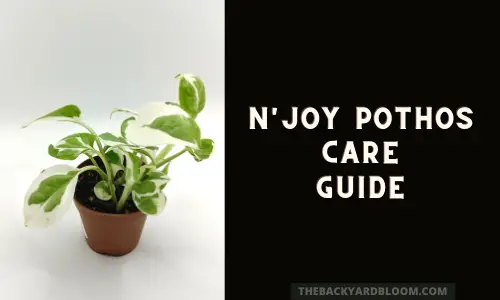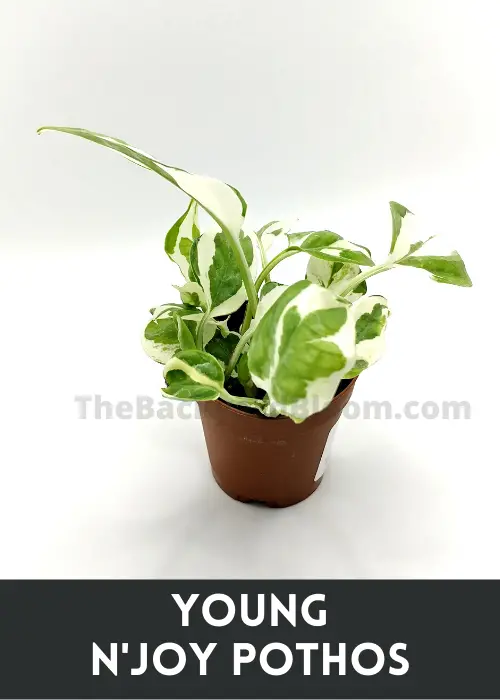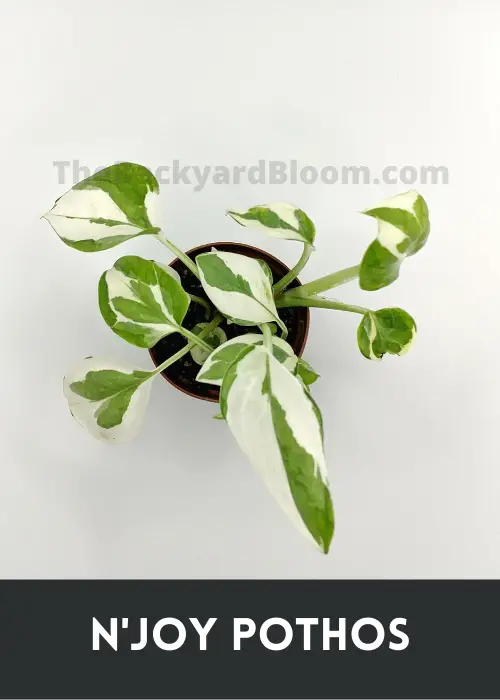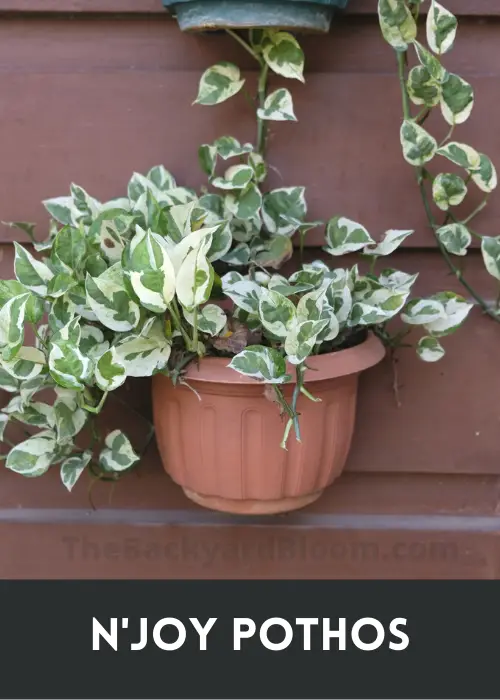N’Joy Pothos are known for their small compact leaves and vines along with their distinct variegation of the leaves. The N’Joy has variegated leaves that are green and white or cream-colored with no flecks of green in the white/cream portion of the leaf. This type of Pothos is known for its picker behavior when compared to the very hearty varieties of Pothos such as the Golden Pothos. But even with the bit of extra care that they need, they are highly sought after by Pothos plant lovers. In this N’Joy Pothos care guide, we go over what you need to do to help your N’Joy thrive.

N’Joy Pothos Plant Origins
The N’Joy Pothos is a result of a breeding program in India that was planned to get brighter variegation in mutations from the Marble Queen Pothos. Over the period of several years, clones were selected based on their shorter internodes and bright variegation that eventually resulted in the mutation that was known and patented as the N’Joy.
The patent was filed in 2007 and is anticipated will expire in 2027.
N’Joy Pothos Care Tips
- Put your plant in bright indirect light.
- Use a well-draining potting soil.
- Keep out of reach of pets.
- Repot every year or two once your N’Joy is older. More often when smaller.
- Don’t let the temperatures drop below 50.
- Humidity 40% to 60% is optimal.
- Using a humidifier is a better idea than misting the plant.
Other Pothos Care Guides:
- Marble Queen Pothos Care
- Global Green Pothos Care
- Baltic Blue Pothos Care
- Pearls and Jade Pothos Care Guide
- Golden Pothos Care Guide for Indoors
- Pothos Plant Care
- Neon Pothos Care Guide
- Manjula Pothos Care Guide
- Cebu Blue Pothos Care
- Jade Pothos Care Guide

N’Joy Pothos Watering Needs
N’Joys can be a bit more touchy to watering than other Pothos. Allow the top few inches of the soil to dry before watering your N’Joy.
To test the soil moisture just use your finger and stick it into the soil to see how it feels. If you can’t use your finger to test this, you can get a moisture meter. Just be aware they are not always the most accurate way to test soil moisture.
Do not overwater your N’Joy. If the plant is overwatered this can lead to it sitting in soggy soil and getting root rot.
When Should I Water My N’Joy Pothos?
While some say that houseplants prefer to be watered at a certain time in the day it doesn’t really matter that much. I usually do try to water my houseplants in the evening, but if you can’t do it then that’s ok. As long as you aren’t overwatering or underwatering them it’s fine.
One of the biggest mistakes new plant owners make is trying to stick to a watering schedule. This can lead to the plant not getting enough water or getting too much. Always test the soil moisture to see if your plant needs water. If the soil is still moist, wait to water it. If the soil is dry it is time to water your Pothos.
N’Joy Pothos Light Requirements
With the N’Joy having a lot of variegation it does need brighter light than non-variegated or lightly variegated cultivars of Pothos. Bright indirect light is best. North-facing windows are a great option, or eastern-facing too. Avoid direct sunlight as this can cause your Pothos to burn.
If you have a hard time getting the plant enough light it can start to lose its variegation on the new growth. Another effect of not enough light is slow growth of the N’Joy Pothos. One option available if you don’t have enough light for the plant is to get a LED grow light. This can help supplement light for the plant and help it get enough to keep its beautiful variegation in its leaves as it grows.
Soil
Regular potting soil with some added perlite will work for the N’Joy Pothos. They are a bit more picky than older varieties such as the Golden Pothos, so just make sure that you get good quality soil and that the soil is well-draining. Drainage of the soil is essential in helping prevent problems such as root rot.

Repotting
Repotting with Pothos plants does not have to be done too frequently once the plant is established in a good-sized pot (6 inches and over). If it is in a smaller pot you might be needing to repot the plant more often.
Repotting usually occurs once every year or two with bigger plants. If you start to see roots growing out of the bottom of your N’Joy or if it is drying out too fast between waterings this is a good indication that it needs a bigger pot. Choose a new pot that is about 2 inches bigger than its current pot and get one that has good drainage.
Fertilizer
N’Joys only need to be fertilized twice per year. Once in the spring and again in the summer when the plant is in its growing season. Use a liquid fertilizer for house plants and cut the dosage in half.
Temperature
Like many tropical plants, the N’Joy does not like low temperatures. Don’t let the temperature drop below 50 degrees Fahrenheit. Also anything above 90 degrees Fahrenheit is not good for these plants.
Humidity
Like other Pothos and tropical houseplants, the N’Joy Pothos prefer higher levels of humidity. 40% to 60% is good. But they can adjust when humidity levels are lower.
Where I live humidity fluctuates often and can drop to 20% easily and go as high as 70% at other times. The biggest difference that I see when the humidity is low is that growth slows down on my Pothos and that they need to be watered more often during this time.
Should I Mist My N’Joy Pothos?
You can try and mist your plant during the times when the humidity levels are low. Misting the plant might not make too much of a difference though. I find that humidifiers make more of an impact than misting my Pothos when the humidity goes down to low levels.

Pruning
Pruning your N’Joy will depend on how fast it is growing. If you are giving it the right amount of light, fertilizer when it needs it and the right amount of water you might want to cut back some of the growth but you don’t have to.
If you want to let the plant trail, then let its vines grow. Remove any damaged or dead leaves though.
If you want your N’Joy to have a fuller look then pruning the plant back as it grows can help achieve this.
N’Joy Pothos Propagation
Like all pothos, the N’Joy is easy to propagate via stem cutting. You can follow the directions on how to propagate a Pothos here to make new N’Joys out of cuttings that you get from your plant.
N’Joy Pothos Plant Toxicity and Pets
All pothos plants, including the N’Joy, are toxic to both cats and dogs due to calcium oxalates that are present in the plant. If you do have pets, keep Pothos plants up and out of their reach.
Common N’Joy Pothos Problems
References:
- Devils Ivy; ASPCA; https://www.aspca.org/pet-care/animal-poison-control/toxic-and-non-toxic-plants/devils-ivy
- Epipremnum Plant Named ‘NJOY’; Google Patents; https://patents.google.com/patent/USPP19965P2/en